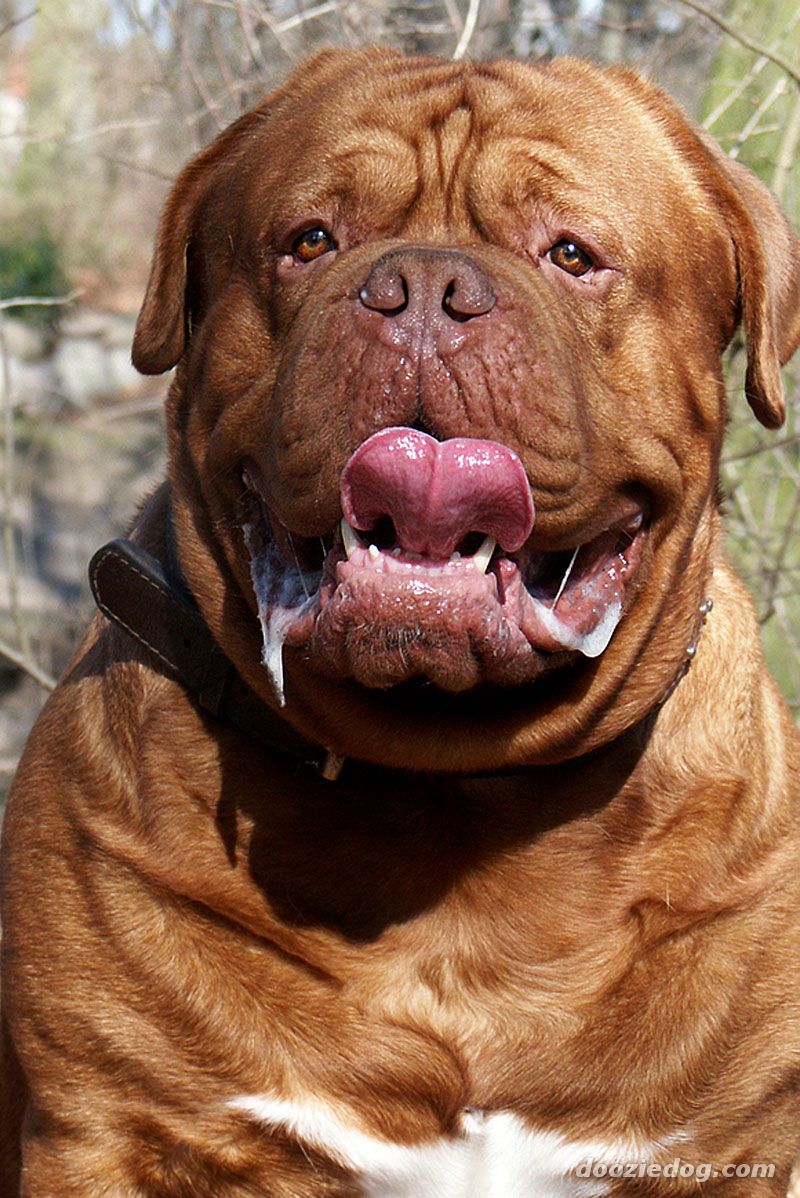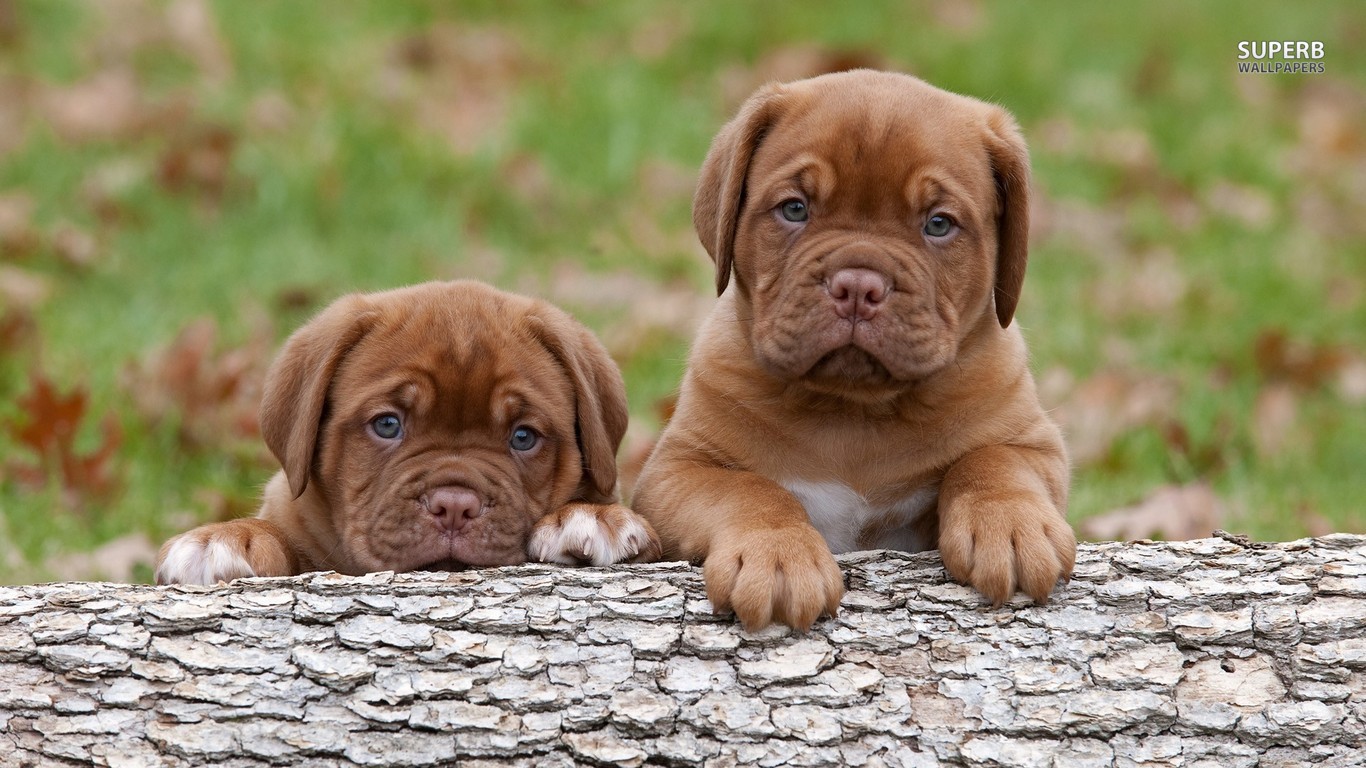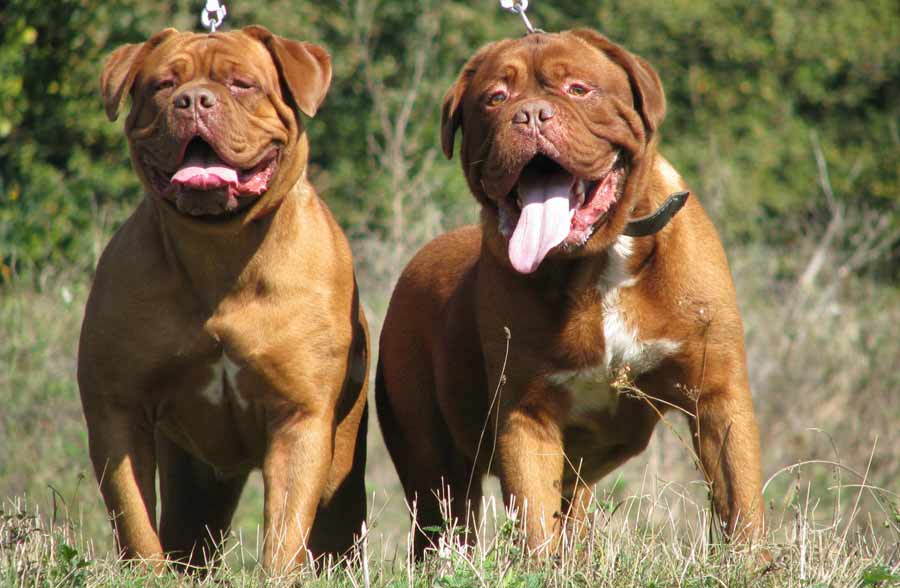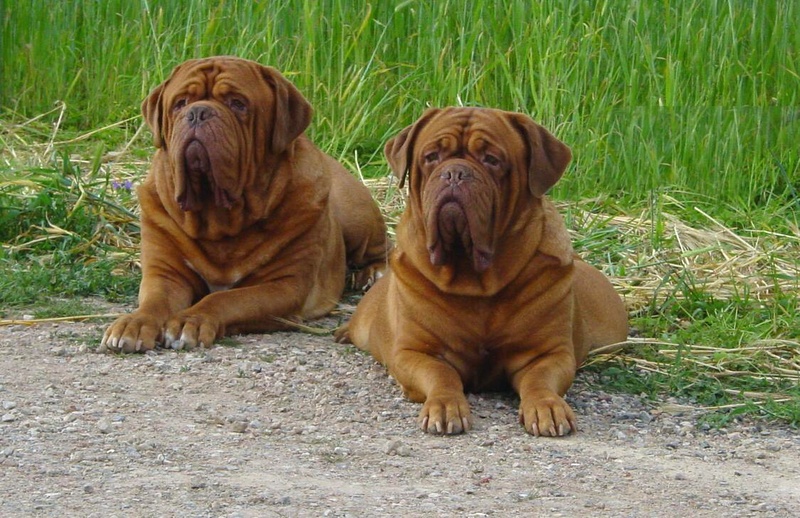
The Breed History
The Dogue de Bordeauxs' is believed to predate the Bullmastiff
and the Bulldog. One theory has the breed originating from the
Tibetan Mastiff and related to the Greco Roman molossoids used
for war at the time of Julius Caesar. Others suggest that the breed
existed in ancient France as the Dogues de Bordeaux of Aquitaine.
Breed setbacks occurred during the French Revolution (when many
of the Dogues de Bordeaux perished with their wealthy masters),
and again following World War II. The breed was imported into the
United States in the 1890s. During the 1960s, a group of breeders
of the Dogue de Bordeaux in France, headed by Raymond Triquet,
worked on the rebuilding of the foundation of the breed. In 1970
a new standard was written for the breed, with the most recent
update in 1995. This standard is the basis of the standard written
for the AKC in 2005.
Breeding for Function
The Dogue de Bordeaux was used as a guardian, a hunter, and a
fighter. They were trained to bait bulls, bears, and jaguars, hunt
boars, herd cattle, and protect the homes, butcher shops, and
vineyards of their masters.
Physical Characteristics
Height at Withers: female 23-26" (58.5-66 cm), male 23.5-27"
(60-68.5 cm)
Weight: females at least 99 lb (45 kg) , males at least 110 lb (50 kg).
Coat: All shades of fawn. No mask, or a black or brown mask.
Limited white patches are allowed on the chest and paws.
Longevity: Average 5.29 yrs based on the DDBS Longevity Study.
Oldest dog was 12 years.
Points of Conformation: The length of the body, measured from
the point of the shoulder to the point of the buttock, is greater than
the height at the withers, in the proportion of 11/10. The depth of
the chest is more than half the height at the withers. The head is
large, rather short, and trapezium shaped when viewed from above
and in front. The eyes are oval and set wide apart. The ear is small
in proportion to the skull and of a slightly darker color than the
coat. The cheeks are prominent due to the very strong development
of the muscles. The bite is undershot so that there is no contact
between the upper and lower incisors. The lower jaw curves
upwards. The skin is supple, ample and loose. The tail preferably
reaches the hock but not below. the Dogue is well up on his toes
despite his weight. The gait is supple and close to the ground, with
great reach and drive.
Recognized Behavior Issues and Traits
The Dogue de Bordeaux is gifted for guarding, which he assumes
with vigilance and great courage but without aggressiveness. He is
a very good companion, being attached to and affectionate toward
his master. He is calm and balanced with a high stimulus threshold.
The male normally has a dominant character. The breed can be very
aggressive with other dogs. Due to their head conformation, they
snore and drool.
Normal Physiologic Variations
Heart size and echocardiographic measurements in the breed are
more consistent with smaller sized breeds such as the Golden
Retriever.
According to a UK study 22.8% of litters are delivered via C-section.
Drug Sensitivities
None Reported
Inherited Diseases
Hip Dysplasia: Polygenically inherited trait causing degenerative
joint disease and hip arthritis. OFA reports 56% affected.
Elbow Dysplasia: Polygenically inherited trait causing elbow
arthritis. OFA reports 21.3% affected.
Multifocal Retinopathy/Retinal Dysplasia: Autosomal recessive
retinal pigment epithelial dysplasia causing localized multifocal
retinal detachments. Age of onset from 11 to 13 weeks of age.
Reported in 3.33% of Dogues de Bordeaux CERF-examined by
veterinary ophthalmologists between 2000-2005. CERF does not
recommend breeding any Dogue de Bordeaux with retinal dysplasia.
A genetic test is available.
Patella Luxation: Polygenically inherited laxity of patellar ligaments,
causing luxation, lameness, and later degenerative joint disease.
Treat surgically if causing clinical signs. OFA reports 2.2% affected.
Disease Predispositions
Aortic Stenosis (AS): Narrowing of the outflow tract of the
heart, causing a murmer and possible later heart disease. 72% of
Dogues de Bordeaux have an aortic murmur, with 17% having
echocardiographic aortic outflow velocity consistent with aortic
stenosis. Undetermined mode of inheritance. An Isreali cohort had
concurrent tricuspid valve dysplasia.
Ectropion: Rolling out of eyelids, often with a medial canthal
pocket. Can cause secondary conjunctivitis. Can be secondary
to Ectropion is reported in 16.67% of Dogues de Bordeaux CERF
examined by veterinary ophthalmologists between 2000-2005.
Distichiasis: Abnormally placed eyelashes that irritate the cornea
and conjunctiva. Can cause secondary corneal ulceration. Reported
in 6.67% of Dogues de Bordeaux CERF examined by veterinary
ophthalmologists between 2000-2005.
Persistent Pupillary Membranes: Strands of fetal remnant
connecting; iris to iris, cornea, lens, or involving sheets of tissue.
The later three forms can impair vision, and dogs affected with
these forms should not be bred. Identified in 6.67% of Dogues de
Bordeaux CERF examined by veterinary ophthalmologists between
2000-2005.
Cranial Cruciate Ligament (ACL) Rupture: Traumatic tearing of the
ACL in the stifle, causing lameness and secondary arthritis. Treat with
surgery. Reported at an increased incidence versus other breeds.
Gastric Dilatation-Volvulus (Bloat, GDV): Polygenically inherited,
life-threatening twisting of the stomach within the abdomen.
Requires immediate veterinary attention. Reported cause of death
of 14.74% of Dogues de Bordeaux.
Lymphoma/Lymphosarcoma: Malignant cancer of the lymphoid
tissue. Treatment with chemotherapy. Reported cause of death of
10.4% of Dogues de Bordeaux.
Hypothyroidism: Inherited autoimmune thyroiditis. 3.8% positive
for thyroid autoantibodies based on testing at Michigan State
University. (Ave. for all breeds is 7.5%). A study in France found
4.5% affected.
Cataracts: Nuclear and punctate cataracts predominate in the
breed. Identified in 3.33% of Dogues de Bordeaux CERF examined
by veterinary ophthalmologists between 2000-2005. CERF does not
recommend breeding any Dogue de Bordeaux with a cataract.5
Corneal Dystrophy: Dogues de Bordeaux can have an epithelial/
stromal form of corneal dystrophy. Reported in 2.22% of Dogues de
Bordeaux CERF examined by veterinary ophthalmologists between
2000-2005.
Idiopathic Epilepsy (Inherited Seizures): Can be generalized or
partial seizures. Treat with anticonvulsant therapy. Reported cause
of death of 2.22% of Dogues de Bordeaux.
Palmoplantar Hyperkeratosis (Corny Feet): A disease of abnormal
hardening and proliferation of the footpads. Affected dogs develop
abnormal footpads around 6 months of age, which then fissure
and crack, predisposing them to secondary infection. Undetermined
mode of inheritance.
Isolated Case Studies
Suspected Primary Immune Deficiency: A young Dogue de
Bordeaux presented with chronic intermittent antibiotic responsive
gastrointestinal and respiratory disease, lymphadenitis, tracheitis,
hypogammaglobulinaemia, and the absence of B-lymphocytes in
lymphoid tissue. A possible B-cell congenital immune deficiency
was suspected.
Lymphocytic Insulitis/Juvenile Diabetes Mellitus: A 3-mo-old
Dogue de Bordeaux presented with persistent hyperglycemia and
insulinopenia. Histological analysis of the pancreas T-cell infiltration
of the islets of Langerhans, demonstrating an immune mediated
juvenile diabetes.
Congenital Valvular Pulmonic Stenosis, Tricuspid Valve Dysplasia,
and Chronic Atrial Fibrillation: A 4-year-old male Dogue de
Bordeaux dog with congenital valvular pulmonic stenosis, tricuspid
valve dysplasia, and chronic atrial fibrillation had its ventricular heart
rate controlled with a novel vagal stimulation system.
Thoracic Stenosis: Two immature Dogues de Bordeaux presented
for treatment of paraparesis. Thoracic stenosis was found at T4-6,
with lateral compression of the thoracic spinal cord caused by
over-sized pedicles. Dorsal laminectomy and partial pediculectomy
stabilized their condition.
Genetic Tests
Tests of Genotype: Direct test for Multifocal Retinopathy is
available from Optigen.
Tests of Phenotype: CHIC Certification: Cardiac examination
by a cardiologist, elbow, hip, and shoulder radiographs. Optional
tests include CERF eye examination, thyroid profile including
autoantibodies, and patella evaluation. (See CHIC website;
caninehealthinfo.org).
Miscellaneous
- Breed name synonyms: French Mastiff, Bordeaux Bulldog.
- Registries: AKC, CKC, ANKC (Australian National Kennel Club),
NKC (National Kennel Club), FCI.
- AKC rank: (year 2008): 41 (3,223 dogs registered)
- Internet resources: Dogue de Bordeaux Society of America:
ddbs.org
Canadian Dogue de Bordeaux Club:
canadiandoguedebordeaxclub.org
Dogue de Bordeaux Club of Great Britain:
doguedebordeauxclub.co.uk
Photo Gallery of Breed - Dogue de Bordeaux - Dog Breed








 Animalia Life
Animalia Life